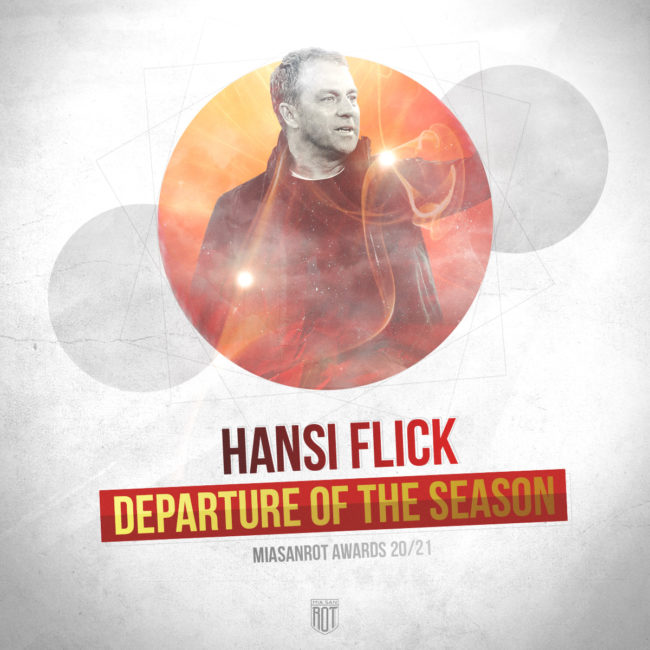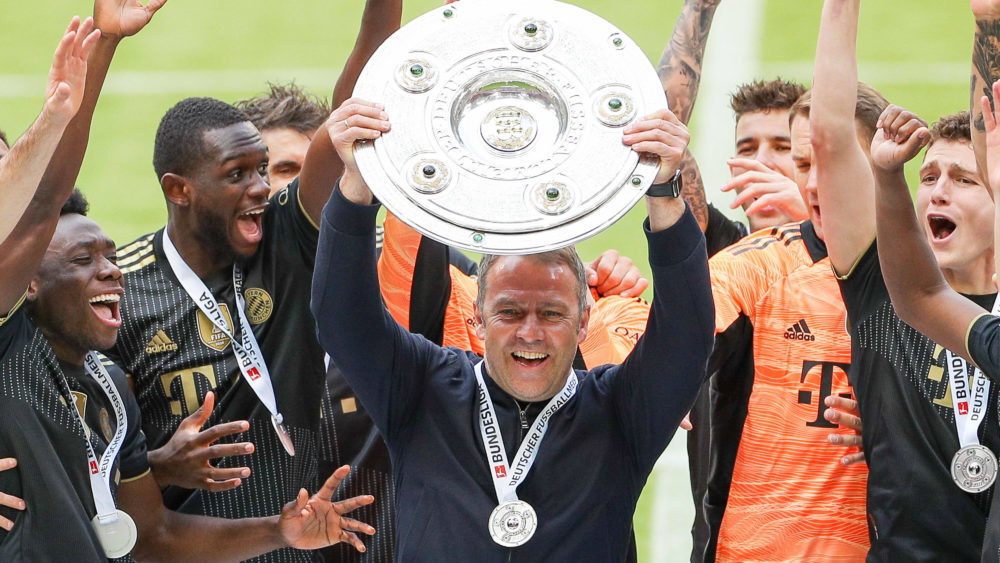MSR awards 20/21 Season: Departure of the season
What made Flick football so special? This is what this article seeks to examine. For this, we will focus on the component that should be most decisive for evaluating a coach: the day-to-day work on the pitch.
Uncompromising high-intensity pressing
Flick’s style of play was aimed at maximising his team’s offensive potential. A distinctive feature of his was the team’s high attacking press with extremely high full-backs in order to uncompromisingly close down and put under pressure the opposing build-up players. The goal was to win the ball as early and high as possible, ideally far inside the opponent’s half and thus minimize the distance to the opponent’s goal. This approach to a game is in line with one of Flick’s most stressed principles: Purposeful play in possession of the ball. Since scoring goals is intrinsically an offensive undertaking, every player’s first thought seemed to be directed forward: Is there a passing option for me in behind or between the lines? Can I play a vertical pass overplaying an opponent’s line? Can I dribble past an opponent’s line? How can I help create the next chance?
Offensive focus
The uncompromising nature of Flick’s game is evident not only in the actions of the players on the pitch, but also in the fact that he nailed his colors to the mast of all-out attack no matter what. Despite all the critics, he stuck to his line, even though Bayern’s defensive fragility (totalling 44 goals conceded at the end of the season) was already undeniable at the beginning of the Rückrunde. The high attacking press Flick employed meant that the last defensive line usually progressed up to the halfway line, and at times even far into the opponent’s half. Due to the high pressing full-backs, the actual defense often consisted only of the two centre-backs. If the opponent was able to break through Bayern’s high press, there were several situations in which the Bayern back line (such as it was) was breached with a simple long ball or was susceptible to counter-attacks in a way that sometimes made them look naïve.

Why Flick’s insistence on attack despite the defensive vulnerability of his team does not have to be due to stubbornness, but on the contrary can make a lot of logical sense for a team like Bayern, we have explored in detail elsewhere. In a nutshell: Football is a low scoring game – one goal more or fewer can often decide the outcome of the game. At the same time, football as an activity is very dependent on chance. No coach in the world is able to foresee and legislate for all possible situations that might arise. Too many factors play a role in a game that as a process is very complex and at the same time highly dynamic.
“Against the […] backdrop of the randomness of a football match and its nature as a low-scoring game, it is always advisable for the stronger team to try to score as many goals as possible in order to outweigh the disproportionate advantage the weaker team has at low scorelines, even if this means taking additional defensive risks while doing so. A score of 0-0 during a game is always disproportionately advantageous for the weaker team because it can at any time score the 1-0 and win the match through sheer luck. The stronger team’s most effective antidote against this is to score so many goals in every game that even massive luck on the part of the opponent (or being extremely unlucky oneselves) cannot change the ultimate outcome of the game.” (Alexander)
Positional play
The positional play under Flick was not as sophisticated as under Guardiola, but he brought his own approach which was aligned with the strengths of his players. In the attacking third, Flick relied on a consistent occupation of the wings, the half-spaces and the center, which often resulted in five players in the first line always occupying all nominal positions – in a fluid order. Based on Flick’s preferred 4-2-3-1, the wide positions were often taken by the half-space players (Coman/Gnabry). The half-spaces in turn were engaged by a 6 (Kimmich/Goretzka) and the 10 (Müller). Lewandowski usually stayed in the center-forward position. So all relevant offensive positions were always occupied by these five players (or their backups) in a dynamic yet coordinated manner.
“When the Flick Bayern were at their peak, these runs were perfectly coordinated. While some players dropped, others pushed up to stretch the space between the lines. The follow-up action was usually a pass back to the deeper 6, a direct ball out wide, or a turn and a dribble or a quick one-two.” (Justin)
The dynamic positional play allowed the team to almost always find good solutions in build-up play, which often led to quick and purposeful goal scoring. What Flick demanded from his players in build-up was situation-adapted decisions and an error-free passing game. He left the live decisions (dribbling vs. passing, slowing down the game vs. speeding it up) to the players and their individual abilities. Flick only set the perimeter of acceptable actions based on a clear idea of the game, but let the players act freely within it. At the same time, his confidence in the players seemed to give them enough room to use their individual abilities to the best advantage of the team.
Collective football instead of individual football
Bayern have incredibly good footballers in their squad – first and foremost Robert Lewandowski, who pulled off the feat of scoring 41 goals this season, thus becoming the Bundesliga’s top scorer and breaking Gerd Müller’s record, which had been considered unassailable. Flick managed to ensure that his players were able to use their skills effectively as individualists and still act in the greater interest of the team. Here, too, we find a reason why it was so important that Flick stuck to the dynamic positional play in attack. If he had made the game more static, the style of play could quickly have shifted from a collective to an individual focus. The necessity to coordinate well, to have an acute perception of even the most minimal movements of the teammates, is only enabled by the dynamic dimension of the game. This forces all players to get involved and buy into in the system. A high attacking press also requires acting as a team. What happens when someone does not participate or is only a fraction of a second too late could be seen at the beginning of the Rückrunde, when the number of goals conceded due to simple long balls over the top and counter-attacks after unsuccessful pressing increased considerably. But Flick managed to do what Niko Kovač could not: He welded the individual abilities of his players into a coherent system so that they acted as a team and not as a collection of individuals.
Too much of a good thing?
As described at the beginning, Flick football requires a very high level of intensity and demands a lot from the players both physically and mentally. The team’s overall distance covered may have been low (17th place in the league), but the intensity of the actions in attacking pressing was all the higher (2019/20: 264 sprints per game, 2020/21: 242 sprints per game – both well above league average). Mentally, the uncompromising pressing behaviour required constant attention and thus a very good perception of potential pressing triggers, the runs of teammates, and the dynamic positioning of opponents.
A lot went Bayern’s way in the 2019/20 season, not least because of the fortunate timing of the COVID-19 breaks. In the decisive phases of the season, Flick was able to work with a rested, fit team. Therefore, they could implement his style of play at a high level with consistency. Given the nature of the defensive vulnerabilities Bayern showed throughout the 20/21 season (being opened up at the back with a long ball over the top often following a failed pressing action high up the pitch), the question arises as to whether Flick’s style of play was not at times too intense for a long season. This question cannot be answered conclusively because there were too many different factors involved in Bayern’s performance last season. Squad planning, lack of summer preparation, difficult integration of new arrivals and unfavourable injuries are just a few examples. No playing style is perfect – there will always be pros and cons.
I, for one, will miss the characteristic Flick power football. Ultimately, I would always prefer an uncompromising offensive focus that comes at at the expense of certain defensive weaknesses as Flick used it over the opposite approach that provides stability at the back but lacks spectacle in attack. Or, as Alexander recently wrote: “We’ll not see this kind of football again for a long time. The clarity of concept, the single-minded focus, the intensity, the unconditional front foot football, the dominance.”





